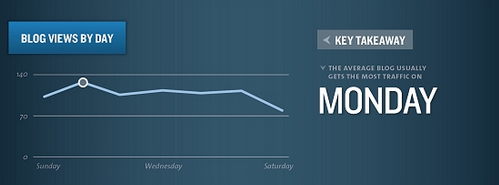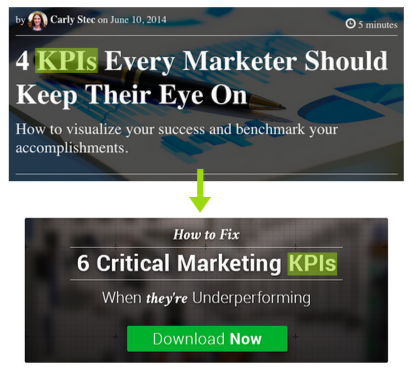Topics:
Marketing StrategySubscribe now and get the latest podcast releases delivered straight to your inbox.
 Yesterday marked my 300th contribution to The IMPACT Blog.
Yesterday marked my 300th contribution to The IMPACT Blog.
While I wish I could say that the road to 300 was paved with rose petals, it's been a long, strange trip.
Needless to say, the late nights, minor profanity, and seemingly endless revisions have taught me a lot about what works (and what doesn't.)
So I dove into the analytics and turned up my top 15 posts of all time to see what sort of insights I could pull from them.
Below you'll find 7 lessons that I've learned this year. Some are data-backed, others are inspired by my own experiences, yet both reveal a lot about business blogging best practices.
My top 15 most-viewed articles:
1) 4 Royalty Free Image Sites You Probably Didn’t Know About
2) How the Most Successful Software Companies Grow [SlideShare]
3) The Secret to Higher Email Marketing Open Rates
4) It’s Not Okay to Make These Email Marketing Mistakes
5) 5 Must Have Google Chrome Extensions You Needed Yesterday
6) 6 "Boring" Companies With Remarkable Marketing Strategies
7) 30 Quotes That Will Inspire You to Write Better Content
8) Does Your Website’s Homepage Answer These 4 Important Questions?
9) 3 Social Media Tools That Will Make Your Life Easier
10) 5 Quotes That Explain How Effective Social Media Marketing Works
11) How to Make Your "About Us" Page a Valuable Sales Tool
12) Content Isn’t Converting? Try This
13) The Worst Unsolicited Email We’ve Ever Seen
14) The 50 Best Pieces of Entrepreneurial Advice You’ll Ever Hear
15) 10 Practical Social Media Tips From Guy Kawasaki
7 lessons learned from writing 300 blog posts in one year:
1. Mondays rule
A while back I saw an infographic from KISSmetrics that revealed that the average blog usually gets the most traffic on Monday.

According to my own results, 40% of my top performing blog articles, were in fact, published on a Monday.
(Followed by 20% on Tuesdays, 6.66% on Wednesdays, 6.66% on Thursdays, 6.66% on Fridays, and 20% on Saturdays.)
While this doesn't mean that you should discredit every other day of the week, it's good information to keep tucked away for when it comes time to pick a launch date for that campaign you've been working on all quarter.
2. People love listicles
This is nothing we haven't heard before.
List posts have been sweeping the Internet for a while now, however, there is often speculation regarding whether or not they continue to hold their relevance.
According to my findings, over 50% of my most-viewed posts were, in fact, listicles.
The reason being that people are drawn to posts that set the expectation up front. List posts are explicit, in that the reader knows exactly what they're going to get out of the content before they even click it.
As a result, there is less risk attached and they are more inclined to take action.
3. Title length matters
Usability research has revealed that people are known to scan headlines, and they tend to take in only the first and last 3 words.
If that's the case, this implies that the ideal length for your blog title would be 6 words to ensure nothing is missed. (Source: KISSmetrics)
According to my 15 top performing posts, the average number of words in each title was 8, which is certainly not far from the suggested 6.
If you're looking for a good rule of thumb when it comes to title length, try to stick to less than 60 characters (with spaces), as the average character count for my top 15 was 53 characters.
While some titles may serve as an exception, the goal is to make sure that every word you're using matters.
4. CTA alignment is critical
After switching gears, I took a look at my top 15 posts with the highest CTA click-through rate.
While we make it a point to ensure that every CTA we include in a post is aligned with the content that comes before it, nearly 50% of these 15 posts had CTAs that contained at least one of the exact same words used in the title.
Check out this example:
 It's clear that this type of specificity helps to persuade people to take the next step.
It's clear that this type of specificity helps to persuade people to take the next step.
Think about it.
If you're reading a blog post about KPIs, it's likely that you're struggling with the concept or looking to better your understanding, right?
With that being said, it makes the most logical sense to follow up with an additional relevant resource, rather than something about social media or blogging.
5. A blog editorial calendar is a necessity
I'm 1000% certain that I would have lost my sanity by now if it hadn't been for Trello.
If you haven't heard of it yet, Trello is a highly interactive project management app that we use to host our blog editorial calendar.
The calendar employs customizable boards that you can attach digital cards to which represent tasks, topics, projects, etc.
Thanks to the drag-and-drop functionality, it's easy to move each card across different boards to keep track of what needs to be done, what you’ve started, and what you’ve completed.
We've found that organizing our boards by buyer persona has helped us to ensure that we are only moving forward with titles that speak directly to our ideal audience's pain points.
6. It helps to find your groove
About 50 blog posts into my career, I found that I do my best work in the morning with a cup of tea and a solid Spotify playlist.
The point that I'm trying to get across is that writing well is about knowing exactly what you need to do in order to turn out the best results. It's about finding your groove.
Aware that often times the hardest part is getting started, figuring out when, where, and how you are most productive before hand helps to eliminate the decision making that arises when we struggle to put the pen to the paper.
The less energy you spend making decisions prior to even getting started, the more energy you'll have to focus on what actually matters.
7. You're going to spell things wrong (& people are going to notice)
Sometime last year, I wrote a blog post about the importance of proofreading your articles to ensure credibility.
As luck would have it, there was a big, fat spelling error hanging out in the second paragraph.
[Insert facepalm here.]
The truth is, it's tough to catch your own mistakes.
Luckily, I have found a few methods that certainly make the editing process easier. For one, I like to wait until the next day to revisit my post with a fresh pair of eyes.
However, if you don't have the time to wait, try reading your post backwards. I've found that this approach helps me to focus less on the flow of the sentence and more on the accuracy of each individual word.
Cheers to 300 more...
Needless to say, it's been a really rewarding year.
I wrote a lot. I learned a lot. And most importantly, I lived to tell the tale.
So if you're feeling on the fence about committing to your business blog, let this post serve as a reminder of the unparalleled insights at stake.
Trust me, it's worth it.


Order Your Copy of Marcus Sheridan's New Book — Endless Customers!

